 W
WCaranx lugubris, the black jack, black trevally, black kingfish, coal fish or black ulua, is a species of large ocean fish in the jack family Carangidae. The species has a circumtropical distribution, found in oceanic, offshore waters of the tropical zones of the Pacific, Atlantic and Indian Oceans. The species is particularly prevalent around offshore islands such as the Caribbean islands in the Atlantic, Hawaii and French Polynesia in the Pacific and the Seychelles and Maldives in the Indian Ocean. Black jack are rare in shallow waters, preferring deep reefs, ledges and seamounts in clear waters. The species is easily distinguished by its black to grey fins and jet black scutes, with the head having a steep profile near the snout. The largest recorded length is 1 m and weight of 17.9 kg. The black jack lives either individually or in small schools, and is known to school with other species. It is a predatory fish, taking a variety of fish, crustaceans and molluscs as prey. Sexual maturity is reached at 34.6 cm in females and 38.2 cm in males, with spawning taking place between February and September in the Caribbean. The early life history of the species is very poorly understood. Black jack are of high importance to many island fisheries, but are rarely encountered in most continental fisheries. The species has a reputation as a gamefish, and is variably considered a terrible or excellent food fish, although several cases of ciguatera poisoning have been attributed to the species. The species was initially named Caranx ascensionis by Georges Cuvier, however several issues with the use of this name have seen Felipe Poey's name Caranx lugubris become the valid scientific name.
 W
WThe spotfin burrfish, also called the spotted burrfish, Pacific burrfish, spotfin porcupinefish, few-spined porcupinefish, spotfin porcupinefish or few-spined porcupinefish, is a species of fish in the genus Chilomycterus, which is part of the porcupinefish family Diodontidae.
 W
WThe cobia is a species of carangiform marine fish, the only representative of the genus Rachycentron and the family Rachycentridae. Other common names include black kingfish, black salmon, ling, lemonfish, crabeater, prodigal son and black bonito.
 W
WThe Elopidae are a family of ray-finned fish containing a single living genus Elops. They are commonly known as ladyfish, skipjacks, jack-rashes, or tenpounders.
 W
WThe great hammerhead is the largest species of hammerhead shark, belonging to the family Sphyrnidae, attaining an average length of 4.6 m (15 ft) and reaching a maximum length of 6.1 m (20 ft). It is found in tropical and warm temperate waters worldwide, inhabiting coastal areas and the continental shelf. The great hammerhead can be distinguished from other hammerheads by the shape of its "hammer", which is wide with an almost straight front margin, and by its tall, sickle-shaped first dorsal fin. A solitary, strong-swimming apex predator, the great hammerhead feeds on a wide variety of prey ranging from crustaceans and cephalopods, to bony fish, to smaller sharks. Observations of this species in the wild suggest that the cephalofoil functions to immobilize stingrays, a favored prey. This species has a viviparous mode of reproduction, bearing litters of up to 55 pups every two years.
 W
WThe scalloped hammerhead is a species of hammerhead shark, and part of the family Sphyrnidae. Originally known as Zygaena lewini, its genus name was later changed to its current name. The Greek word sphyrna translates into "hammer" in English, referring to the shape of this shark's head. The most distinguishing characteristic of this shark, as in all hammerheads, is the 'hammer' on its head. The shark's eyes and nostrils are at the tips of the extensions. It is a fairly large hammerhead, but is still smaller than both the great and smooth hammerheads.
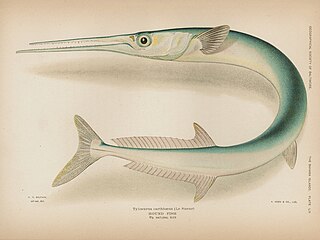 W
WThe houndfish is a game fish of the family Belonidae. It is the largest member of its family, growing up to 5 feet (1.5 m) in length and 10 pounds (4.5 kg) in weight. It is also often called the crocodile needlefish.
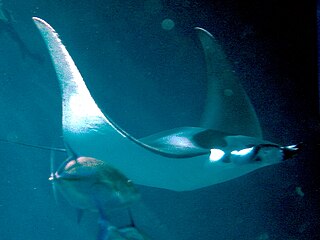 W
WThe spinetail devil ray, also known as the spinetail mobula ray or japanese mobula ray, is a species of pelagic marine fish which belongs to the family Mobulidae. It is found throughout the tropical and sub-tropical waters of the Indo-Pacific and eastern Atlantic Ocean.
 W
WThe sharptail mola is a species of mola found circumglobally in tropical and temperate waters. It is similar in appearance to the ocean sunfish, but can be distinguished by the projection on its clavus (pseudo-tail). Other common names include sharpfin sunfish, point-tailed sunfish, and trunkfish. Rarely encountered, very little is known of the biology or life history of the sharptail mola. It has recently become important to commercial fisheries operating off eastern Taiwan. This species is the only member of its genus.
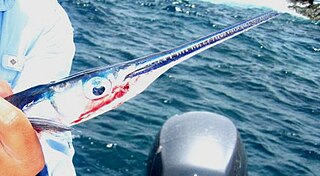 W
WThe flat needlefish, the only known member of the genus Ablennes, is a marine fish of the family Belonidae. Flat needlefish are considered gamefish, frequently caught with the help of artificial lights, but are not often eaten because of their green-colored flesh.
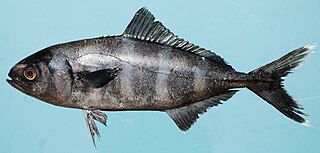 W
WThe pilot fish is a carnivorous fish of the trevally, or jackfish family, Carangidae. It is widely distributed and lives in warm or tropical open seas.
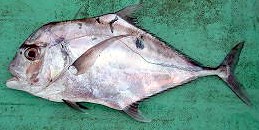 W
WThe African pompano, also known as the pennant-fish or threadfin trevally, is a widely distributed species of tropical marine fish in the jack family, Carangidae. The species is found in tropical waters worldwide, with adults often inhabiting coastlines, while juveniles are usually pelagic, floating with ocean currents. The adult African pompano is similar in appearance to the other members of the genus Alectis, with the concave shape of the head near the eyes; the clearest distinguishing feature. The juveniles are similar to other members of Alectis, having long, filamentous dorsal and anal fin tips which are thought to discourage predators. The species lives in depths less than 100 m, consuming a range of crustaceans and small fishes. The species is of minor economic importance, often taken amongst other tropical midwater fishes by hook and line, while juveniles are occasionally caught in beach seines. African pompano are also highly rated game fish, often considered one of the strongest of the jacks in larger sizes.
 W
WThe black-blotched porcupinefish, also known as shortspine porcupinefish, is a member of the family Diodontidae. It is found in the tropical and subtropical waters of the Indo-Pacific on coral and rocky reefs and in inshore waters. Other names are the blotched porcupinefish and the brown-backed porcupinefish.
 W
WThe long-spine porcupinefish, also known as the freckled porcupinefish among other vernacular names, is a species of marine fish in the family Diodontidae.
 W
WThe spot-fin porcupinefish, also known as the spotted porcupinefish, black-spotted porcupinefish or simply porcupinefish, is a member of the family Diodontidae.
 W
WThe bentfin devil ray, also known as the lesser devil ray, smoothtail devil ray, smoothtail mobula or Thurston's devil ray, is a species of ray in the family Mobulidae. It is found worldwide in tropical, subtropical and warm temperate oceans, with records from Australia, Brazil, Chile, Costa Rica, Ecuador, Egypt, El Salvador, Eritrea, Guatemala, Honduras, India, Indonesia, Ivory Coast, Japan, Malaysia, Maldives, Mexico, Myanmar, Nicaragua, Oman, Pakistan, Peru, the Philippines, Saudi Arabia, Senegal, South Africa, Sri Lanka, Thailand, United Arab Emirates, United States (California), Uruguay and Vanuatu. It likely occurs in many other locations in tropical, subtropical and warm temperate oceans. It is found both offshore and near the coast.
 W
WThe Chilean devil ray, also known as the box ray, greater Guinean mobula, sicklefin devil ray or the spiny mobula, is a species of ray in the family Mobulidae. It is found worldwide in tropical, subtropical and warm temperate oceans, and mainly occurs offshore, only occasionally appearing near the coast. These fish have been discovered to feed at depths up to 1,848 metres (6,063 ft) during deep dives, and are among the deepest-diving ocean animals. There are two distinct deep dive patterns; the first, which is usually only performed once every 24 hours, is diving to the maximum depth and resurfacing after 60 to 90 minutes; the second, which is less frequent, is dives up to 1,000 meters for a maximum of 11 hours. The latter pattern may be associated with traveling rather than feeding. It can reach a disc width of up to 3.7 m (12 ft).
 W
WThe giant oceanic manta ray, giant manta ray, or oceanic manta ray, is a species of ray in the family Mobulidae, and the largest type of ray in the world. They are circumglobal and are typically found in tropical and subtropical waters, but can also be found in temperate waters. Until 2017, giant mantas were classified in the genus Manta, along with the smaller reef manta. DNA testing revealed that both species are more closely related to rays of the genus Mobula than previously thought. As a result, giant mantas were renamed Mobula birostris to reflect the new classification.
 W
WThe bigeye scad is an oceanic fish found in tropical regions around the globe. Other common names include purse-eyed scad, goggle-eyed scad, akule, chicharro, charrito ojón, jacks, matang baka, mushimas and coulirou. The bigeye scad is fished commercially, both for human consumption and for bait.
 W
WThe bignose shark is a species of requiem shark, in the family Carcharhinidae. Distributed worldwide in tropical and subtropical waters, this migratory shark frequents deep waters around the edges of the continental shelf. It is typically found at depths of 90–430 m (300–1,410 ft), though at night it may move towards the surface or into shallower water. The bignose shark is plain-colored and grows to at least 2.7–2.8 m (8.9–9.2 ft) in length. It has a long, broad snout with prominent nasal skin flaps, and tall, triangular upper teeth. Its pectoral fins are long and almost straight, and there is a ridge on its back between the two dorsal fins.
 W
WThe blacktip shark is a species of requiem shark, and part of the family Carcharhinidae. It is common to coastal tropical and subtropical waters around the world, including brackish habitats. Genetic analyses have revealed substantial variation within this species, with populations from the western Atlantic Ocean isolated and distinct from those in the rest of its range. The blacktip shark has a stout, fusiform body with a pointed snout, long gill slits, and no ridge between the dorsal fins. Most individuals have black tips or edges on the pectoral, dorsal, pelvic, and caudal fins. It usually attains a length of 1.5 m (4.9 ft).
 W
WThe bull shark, also known as the "Zambezi shark" in Africa, and "Lake Nicaragua shark" in Nicaragua, is a requiem shark commonly found worldwide in warm, shallow waters along coasts and in rivers. It is known for its aggressive nature, and presence in warm, shallow brackish and freshwater systems including estuaries and rivers.
 W
WThe dusky shark is a species of requiem shark, in the family Carcharhinidae, occurring in tropical and warm-temperate continental seas worldwide. A generalist apex predator, the dusky shark can be found from the coast to the outer continental shelf and adjacent pelagic waters, and has been recorded from a depth of 400 m (1,300 ft). Populations migrate seasonally towards the poles in the summer and towards the equator in the winter, traveling hundreds to thousands of kilometers. One of the largest members of its genus, the dusky shark reaches 4.2 m (14 ft) in length and 347 kg (765 lb) in weight. It has a slender, streamlined body and can be identified by its short round snout, long sickle-shaped pectoral fins, ridge between the first and second dorsal fins, and faintly marked fins.
 W
WThe whitetip reef shark is a species of requiem shark, in the family Carcharhinidae, and the only member of its genus. A small shark that does not usually exceed 1.6 m (5.2 ft) in length, this species is easily recognizable by its slender body and short but broad head, as well as tubular skin flaps beside the nostrils, oval eyes with vertical pupils, and white-tipped dorsal and caudal fins. One of the most common sharks found on Indo-Pacific coral reefs, the whitetip reef shark occurs as far west as South Africa and as far east as Central America. It is typically found on or near the bottom in clear water, at a depth of 8–40 m (26–131 ft).
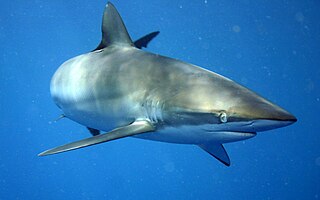 W
WThe silky shark, also known by numerous names such as blackspot shark, grey whaler shark, olive shark, ridgeback shark, sickle shark, sickle-shaped shark and sickle silk shark, is a species of requiem shark, in the family Carcharhinidae, named for the smooth texture of its skin. It is one of the most abundant sharks in the pelagic zone, and can be found around the world in tropical waters. Highly mobile and migratory, this shark is most often found over the edge of the continental shelf down to 50 m (164 ft). The silky shark has a slender, streamlined body and typically grows to a length of 2.5 m. It can be distinguished from other large requiem sharks by its relatively small first dorsal fin with a curving rear margin, its tiny second dorsal fin with a long free rear tip, and its long, sickle-shaped pectoral fins. It is a deep, metallic bronze-gray above and white below.
 W
WThe silvertip shark is a large species of requiem shark, in the family Carcharhinidae, with a fragmented distribution throughout the tropical Indian and Pacific Oceans. It is often encountered around offshore islands and coral reefs, and has been known to dive to a depth of 800 m (2,600 ft). The silvertip shark resembles a larger and bulkier grey reef shark, but can be easily identified by the prominent white margins on its fins. It attains a maximum length of 3 m (10 ft).
 W
WThe tiger shark is a species of requiem shark and the only extant member of the genus Galeocerdo. It is a large macropredator, capable of attaining a length over 5 m. Populations are found in many tropical and temperate waters, especially around central Pacific islands. Its name derives from the dark stripes down its body, which resemble a tiger's pattern, but fade as the shark matures.
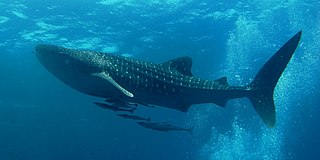 W
WThe whale shark is a slow-moving, filter-feeding carpet shark and the largest known extant fish species. The largest confirmed individual had a length of 18.8 m (62 ft). The whale shark holds many records for size in the animal kingdom, most notably being by far the largest living nonmammalian vertebrate. It is the sole member of the genus Rhincodon and the only extant member of the family Rhincodontidae, which belongs to the subclass Elasmobranchii in the class Chondrichthyes. Before 1984 it was classified as Rhiniodon into Rhinodontidae.
 W
WThe oceanic whitetip shark, also known as Brown Milbert's sand bar shark, brown shark, lesser white shark, nigano shark, oceanic white-tipped whaler, and silvertip shark, is a large pelagic requiem shark inhabiting tropical and warm temperate seas. Its stocky body is most notable for its long, white-tipped, rounded fins.
 W
WThe live sharksucker or slender sharksucker is a species of marine fish in the family Echeneidae, the remoras.
 W
WThe ocean sunfish or common mola is one of the heaviest known bony fishes in the world. Adults typically weigh between 247 and 1,000 kg (545–2,205 lb). The species is native to tropical and temperate waters around the world. It resembles a fish head with a tail, and its main body is flattened laterally. Sunfish can be as tall as they are long when their dorsal and ventral fins are extended.
 W
WThe black triggerfish or black durgon (Melichthys niger), called Humuhumu'ele'ele in Hawaiian, is a blimp-shaped triggerfish with bright white lines running along its dorsal and anal fins. From distance, it appears to be completely black. However, upon closer inspection with good lighting, one can see that it is actually mottled dark-blue/green coloration often with orange toward the front of the head. Black durgons are capable of changing color based on their surroundings.
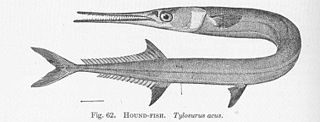 W
WTylosurus acus is a game fish of the family Belonidae.